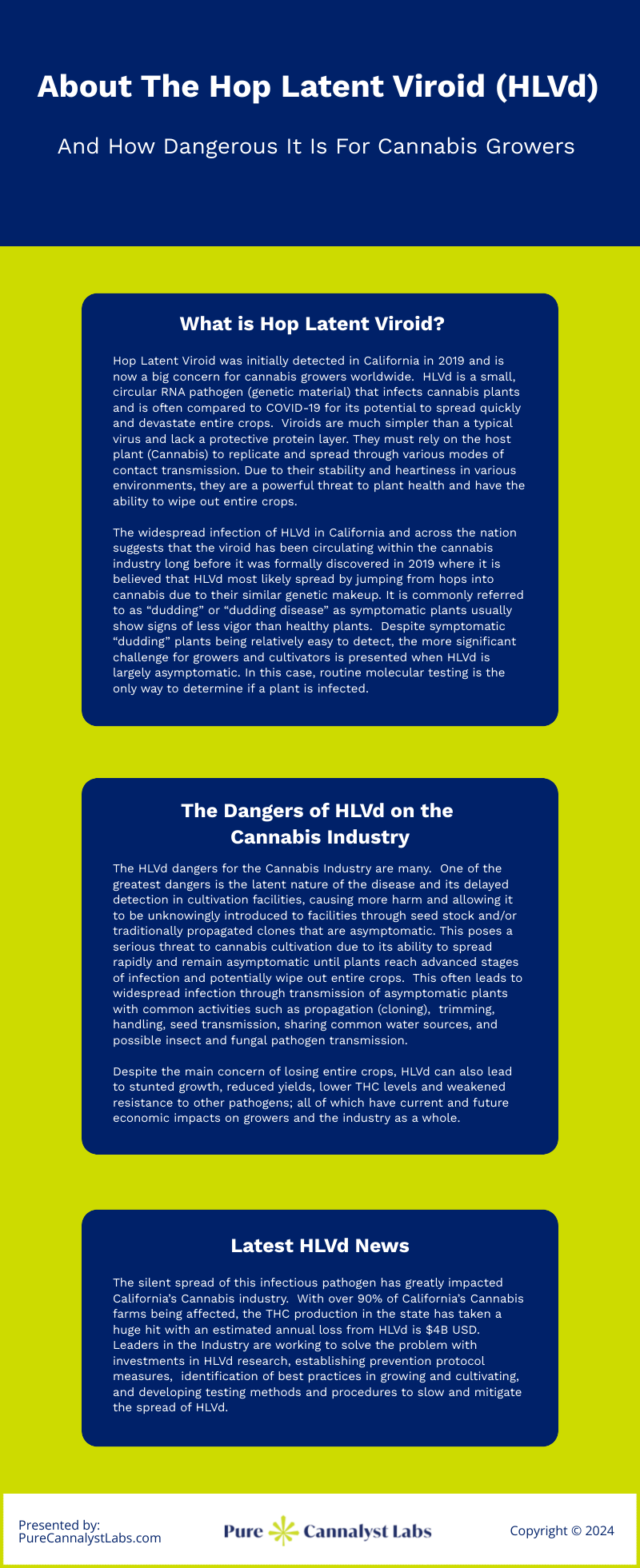Cannabis farmers and cultivators are in constant pursuit of employing best practices to produce high-quality crops while maximizing yields and limiting risks throughout the cultivation process. Staying up to date on industry best practices is complex and by implementing them, cannabis farmers can cultivate healthy, high-quality crops while maximizing yields and minimizing risks throughout the cultivation process.
However, despite keeping up on the latest technology and best practices, there is a new hidden threat to the Cannabis Industry – The Hop Latent Viroid (HLVd).
Table of Contents
ToggleWhat is Hop Latent Viroid?
Hop Latent Viroid was initially detected in California in 2019 and is now a big concern for cannabis growers worldwide. HLVd is a small, circular RNA pathogen (genetic material) that infects cannabis plants and is often compared to COVID-19 for its potential to spread quickly and devastate entire crops. Viroids are much simpler than a typical virus and lack a protective protein layer. They must rely on the host plant (Cannabis) to replicate and spread through various modes of contact transmission. Due to their stability and heartiness in various environments, they are a powerful threat to plant health and have the ability to wipe out entire crops.
The widespread infection of HLVd in California and across the nation suggests that the viroid has been circulating within the cannabis industry long before it was formally discovered in 2019 where it is believed that HLVd most likely spread by jumping from hops into cannabis due to their similar genetic makeup. It is commonly referred to as “dudding” or “dudding disease” as symptomatic plants usually show signs of less vigor than healthy plants. Despite symptomatic “Dudding” plants being relatively easy to detect, the more significant challenge for growers and cultivators is presented when HLVd is largely asymptomatic. In this case, routine molecular testing is the only way to determine if a plant is infected.
The Dangers of HLVd on the Cannabis Industry
The HLVd dangers for the Cannabis Industry are many. One of the greatest dangers is the latent nature of the disease and its delayed detection in cultivation facilities, causing more harm and allowing it to be unknowingly introduced to facilities through seed stock and/or traditionally propagated clones that are asymptomatic. This poses a serious threat to cannabis cultivation due to its ability to spread rapidly and remain asymptomatic until plants reach advanced stages of infection and potentially wipe out entire crops. This often leads to widespread infection through transmission of asymptomatic plants with common activities such as propagation (cloning), trimming, handling, seed transmission, sharing common water sources, and possible insect and fungal pathogen transmission.
Despite the main concern of losing entire crops, HLVd can also lead to stunted growth, reduced yields, lower THC levels, and weakened resistance to other pathogens; all of which have current and future economic impacts on growers and the industry as a whole. The research is still emerging when it comes to Hop Latent Viroid and the Cannabis Industry. Keeping up to date with Cannabis Professional Organizations, Industry Journals, and other industry leaders will assist growers and cultivators in the implementation of prevention measures to mitigate the disease and protect their crops through testing and other methods. One such prevention measure program developed is called the STOP program:
- Sterile – Keeping a sterile environment assists in the spread of Viroids
- Testing – Implementation of routine testing of mother plants
- Organizing – Overall facility and plant organization
- Protecting – Facilities from infected plants
New research in Pathogen Test methods is the most promising development to help eradicate the widespread disease. Emerging developments in this area will help cultivators and growers accurately identify and remove infected plants before the infection spreads to other plants in their facility. There are several factors involving pathogen testing that need to be considered:
Type of Test- Molecular testing (a test that detects the presence of DNA/RNA) is the only test that has been found to detect HLVd and all viroids. PCR is a common molecular test that is the most sensitive and accurate method of testing and can provide both diagnostic and approximate viroid levels. This testing can assist with management decisions about crops and actions necessary to eradicate HLVd. Although there are other classic versions of molecular tests, industry experts have found the PCR test to be the most sensitive and produce the most accurate and reliable results.
Tissue Type- Selecting the correct plant tissue type for testing is an important consideration especially for identifying plants during the early infection stages or those not yet showing as systemic. Some studies completed have shown that root tissue contains the highest levels of HLVd and is the most reliable tissue used for detection of the Viroid Infection.
Testing Frequency – The key to maintaining healthy cannabis crops is to conduct routine pathogen testing. This includes creating a program where mother plants are tested every 4-6 weeks for critical pathogens such as HLVd.
Disinfection Methods- Growers and Cultivators should implement a routine disinfection plan with reliable methods to limit the spread of HLVd. Common disinfection methods like alcohol and hydrogen peroxide are proven to be ineffective against viroids. But, 10% bleach solution has shown efficacy in destroying HLVd. This extends to implementing disinfection methods for all tools and equipment as well.
Latest HLVd News
The silent spread of this infectious pathogen has greatly impacted California’s Cannabis industry. With over 90% of California’s Cannabis farms being affected, the THC production in the state has taken a huge hit with an estimated annual loss from HLVd is $4B USD. Leaders in the Industry are working to solve the problem with investments in HLVd research, establishing prevention protocol measures, identification of best practices in growing and cultivating, and developing testing methods and procedures to slow and mitigate the spread of HLVd.
PCL is Gearing up to Test For it Soon
Understanding HLVd and its symptoms is crucial for timely diagnosis and appropriate disease management strategies. To mitigate the further spread of HLVd and help growers and cultivators protect their current and future crops, here at Pure Cannalyst Labs, an Irvine cannabis testing lab, we are working diligently with experts in developing and launching a comprehensive testing program that will soon be released. In the interim, it is advised to employ the identification and prevention strategies above to assist in the control of the HLVd pathogen spread.
Infographic

